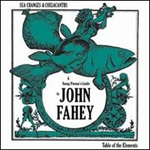|
|
 |
Dusted Reviews
Artist: John Fahey Album: Sea Changes & Coelacanths: A Young Person’s Guide to John Fahey Label: Table of the Elements Review date: Dec. 4, 2006 |

|
|
|
 |
Bob Dylan’s embrace of amplification remains one of the canonical cornerstones of popular music. His act of flipping the proverbial finger to the folkie establishment and plugging in is still widely touted as the gesture that changed the face of all that would follow in one fell swoop. The story makes for good icon building and mythmaking, but it obscures the sobering reality that countless others have traveled the same path prior and since. From McKinley Morganfield plying plantation favorites on an electrified axe in post-war Chicago to Kelly Joe Phelps making a similar switch on his third album for Ryko just a few years ago, the swap of acoustic for electric ain’t nothing new, and it continues to yield a succession of seismic musical ripples large and small.
John Fahey’s conversion came slower than most and was partially the product of necessity in the wake of waning health. Backlash from his decision to incorporate technology was scattered and largely limited to the complaining of fans fixated on his Takoma label beginnings. In fact, several of those albums contained the seeds for the switch as he had been experimenting with electronics and sound collage techniques since the ’60s. Table of the Elements’ colorfully and verbosely titled collection Sea Changes & Coelacanths: A Young Person’s Guide to John Fahey combines two of his best late-in-life projects. The set’s attractive peripherals celebrate Fahey in grand style with suitably gnostic packaging art and a selection of essays authored by David Fricke, Byron Coley, Dave Grubbs deliberating on facets of his history and influence both familiar and fresh.
The “studio” born Womblife occupies most of the first disc. A collaboration with Jim O’Rourke, taped in the younger guitarist’s bedroom, the album makes extensive use of echo, loops and samples on pieces like the bottleneck-by-way-of-sine-drone “Sharks” to create music that is equal parts ambient and terrestrial, fever dream and reverie. Rhythmic gamelan strains complement waves of heavily processed string picking on “Planaria” in another swirling procession of sound particles. On “Eels,” sparse acoustic slides and strumming coexist with an oscillating wind tunnel whir and other assorted electronic atmospherics. “Coelacanths” swims by in a stream of nebulous tones, the clatter of unidentified percussion audible along the fringes. Four fragments from a solo gig at Chicago’s Empty Bottle, originally released as a single-sided LP, close the disc out. They work well as an extension of the earlier session and Fahey revisits a handful of nucleic themes from his Takoma songbook on closely miked steel-string acoustic.
The second disc encompasses all of Georgia Stomps, Atlanta Struts, and Other Contemporary Dance Favorites, a solo electric guitar recital recorded in Atlanta in the summer of 1997. Fahey gives discursive renderings of 10 tunes, the majority joined in medley form. Playing on a borrowed axe, his amplification is cavernous, luminous and often diaphanous, and his improvisations frequently pivot on gradually gestating licks. Nothing sounds hurried as massive soaring chords hang in the air in slow decay. The program reflects his customary diversity of content, straying from completely transfigured jazz numbers like clarinetist Artie Shaw’s “Nightmare” and Ellington’s “Mood Indigo” to vintage Americana like “Red Rocking Chair” and “House of the Rising Son.” “Guitar Lamento” a piece by one of his idols, the Brazilian guitarists Bola Sete, pairs easily with his own “Juana.” His storied chops are audibly atrophied in places, but the shimmering patina of amplification helps in eroding the tedium from occasional cul de sacs and plodding interludes.
Those seeking the virtuosic Fahey of albums like God, Time and Causality will find him largely absent here, but the trade-off comes in a haunting set of performances that can swallow the listener whole, much like the ancient marine life named in the collection’s cryptic title. Someone should send Dylan a copy if he hasn’t heard it already.
By Derek Taylor
|







